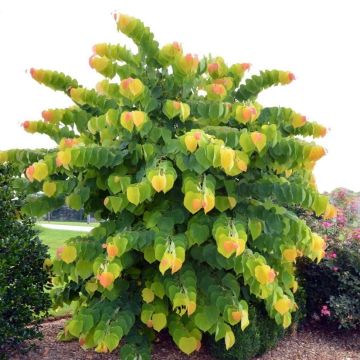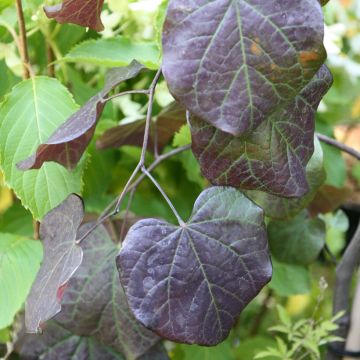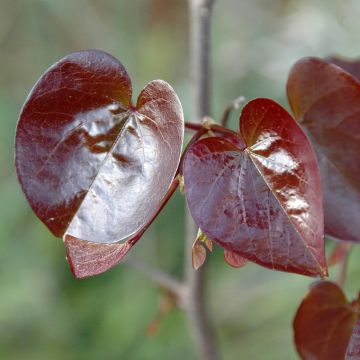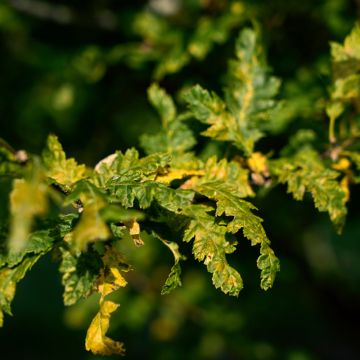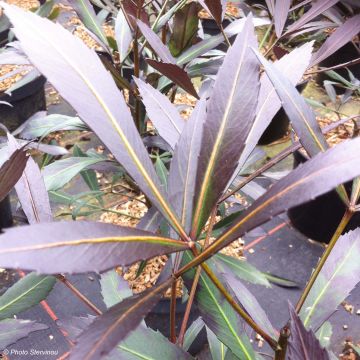

Cercis canadensis Golden Falls - Gainier du Canada 12/15L
Cercis canadensis Golden Falls - Eastern Redbud
Cercis canadensis Golden Falls
Eastern Redbud, Canadian Redbud, American Redbud, Judas Tree
This item cannot be shipped to the selected country
Oversize package delivery charge from €6.90
Delivery to Corse prohibited
More information
Schedule delivery date,
and select date in basket
This plant carries a 24 months recovery warranty
More information
We guarantee the quality of our plants for a full growing cycle, and will replace at our expense any plant that fails to recover under normal climatic and planting conditions.
Oversize package: home delivery by special carrier from €6.90 per order..
Express home delivery from €8.90.
Delivery to Corse prohibited: UE law prohibits the import of this plant from mainland France to Corse as part of the fight against Xylella fastidiosa. Please accept our sincere apologies.
More information
Does this plant fit my garden?
Set up your Plantfit profile →
Description
Cercis Canadensis 'Golden Falls' is a recent and amazing variety of Canadian Redbud. It is distinguished first by its voluminous heart-shaped leaves that change colour throughout the weeks. The young leaves are adorned with orange hues. Then, they turn golden yellow. And as autumn approaches, just before falling, they take on a surprising lemon green colour. But this Canadian Redbud also stands out for its abundant spring flowering in shades of pinkish purple that explodes against an almost black bark, covering the entire length of its branches. The last asset of this bush lies in its elegant weeping habit, both vertical, narrow and upright. Its size is ideal for enhancing a small garden or terrace. This hardy plant needs a sunny location to enhance the intensity of its colours. Not demanding in terms of soil, it nevertheless requires well-drained, not too dry soil.
The Cercis canadensis is a tree native to the eastern and central United States, belonging to the Legume family. It can reach a height of 12 m (39 ft 5 in) in its natural environment, but rarely exceeds 3 to 7 m (9 ft 10 in to 23 ft) in cultivation. It forms a twisted tree, with branches close to the ground, often wider than tall. The Canadian Redbud has given rise to numerous varieties with varied habits, flower colours, and foliage.
Cercis canadensis 'Golden Falls' is a recent American creation, credited to JC Raulstein Arboretum at NC State University. It is characterised by a very compact, upright and weeping habit. Like all varieties of the Cercis genus, its foliage is deciduous and takes on colourful hues before falling in autumn. The 'Golden Falls' variety does not exceed 4 m (13 ft 1 in) in height with a spread of about 1.50 m. Flowering takes place in May-June depending on the climate: its still leafless trailing branches are covered with an abundant rose-purple flowering, greatly appreciated by pollinating insects. They are particularly numerous, butterfly-shaped, grouped in clusters along the branches. Once flowering is over, the Canadian Redbud is adorned with large heart-shaped leaves.
It forms a very original and attractive shrub almost all year round. It takes up little space and has a strong personality: it is an ideal candidate to add a unique touch to a small garden or in the centre of a large flowerbed. It only requires a fairly deep soil, regardless of its nature, even limestone. It is very hardy and can be planted in all regions of France. It does not require any particular pruning: in short, it is a very accommodating plant that can thrive in any garden!
Cercis canadensis 'Golden Falls' can be planted as a standalone specimen for its year-round presence, especially in the middle of a small lawn in front of the house or to add vibrant colours to a flowerbed on the edge of a wood. It also looks stunning against the backdrop of a wall or evergreen foliage accompanied by a Golden Elder 'Plumosa aurea' and a California Lilac 'Concha' for the contrast in colour and form, with some clumps of Darley Heath and Hellebores in their shade for winter! Or, with a dwarf Winged Euonymus and a beautiful Cotinus Grace, adorned with one boasting a beautiful red and orange fruiting, and the other with an airy summer flowering, both offering a sumptuous autumn foliage...
Report an error about the product description
Cercis canadensis Golden Falls - Eastern Redbud in pictures
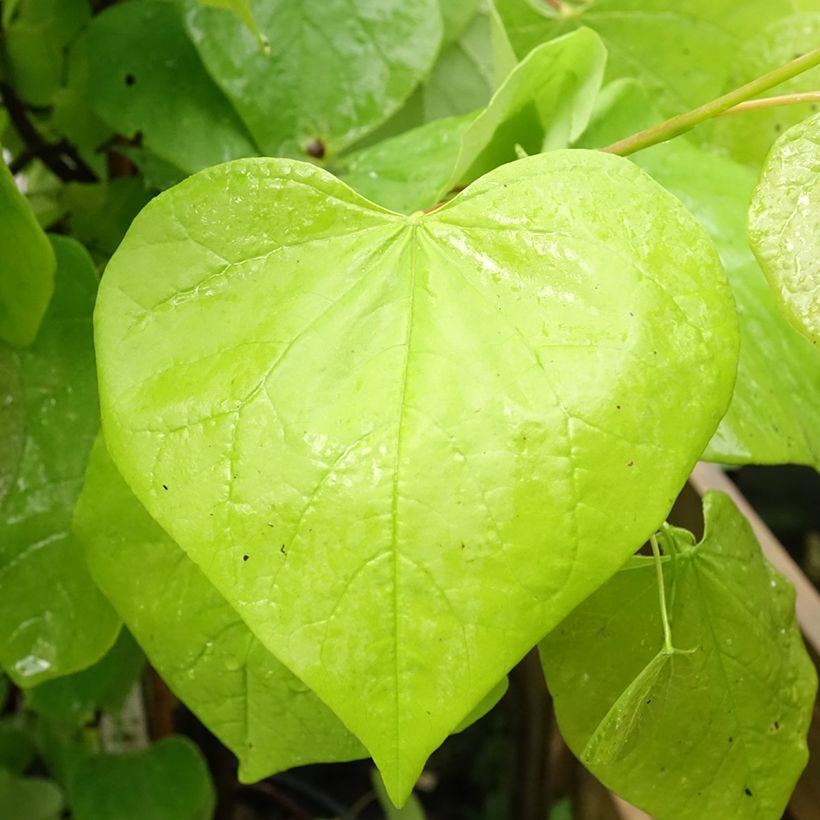

Plant habit
Flowering
Foliage
Botanical data
Cercis
canadensis
Golden Falls
Fabaceae
Eastern Redbud, Canadian Redbud, American Redbud, Judas Tree
Cultivar or hybrid
Other Cercis
Planting and care
The Cercis canadensis 'Golden Falls' likes sun or partial shade. It is not very picky about the nature of the soil, as long as it is deep and retains moisture. In nature, this tree often grows near watercourses. In poor soil, enrich the planting soil with good compost or potting soil. Water it regularly during the first year in case of drought, as this Canadian tree does not tolerate long periods of summer drought, unlike its Mediterranean cousin, the Cercis siliquastrum, which is perfectly adapted to dry and rocky, even arid, soils. It will grow in all types of soil but prefers neutral or acidic soils. It is perfectly hardy (-20°C (-4 °F)), but young shoots can suffer from severe frost in early spring. Protection with horticultural fleece can be useful in the first few years in case of a severe cold spell in March.
Planting period
Intended location
Care
-
, onOrder confirmed
Reply from on Promesse de fleurs
Striking foliage shrubs
Haven't found what you were looking for?
Hardiness is the lowest winter temperature a plant can endure without suffering serious damage or even dying. However, hardiness is affected by location (a sheltered area, such as a patio), protection (winter cover) and soil type (hardiness is improved by well-drained soil).

Photo Sharing Terms & Conditions
In order to encourage gardeners to interact and share their experiences, Promesse de fleurs offers various media enabling content to be uploaded onto its Site - in particular via the ‘Photo sharing’ module.
The User agrees to refrain from:
- Posting any content that is illegal, prejudicial, insulting, racist, inciteful to hatred, revisionist, contrary to public decency, that infringes on privacy or on the privacy rights of third parties, in particular the publicity rights of persons and goods, intellectual property rights, or the right to privacy.
- Submitting content on behalf of a third party;
- Impersonate the identity of a third party and/or publish any personal information about a third party;
In general, the User undertakes to refrain from any unethical behaviour.
All Content (in particular text, comments, files, images, photos, videos, creative works, etc.), which may be subject to property or intellectual property rights, image or other private rights, shall remain the property of the User, subject to the limited rights granted by the terms of the licence granted by Promesse de fleurs as stated below. Users are at liberty to publish or not to publish such Content on the Site, notably via the ‘Photo Sharing’ facility, and accept that this Content shall be made public and freely accessible, notably on the Internet.
Users further acknowledge, undertake to have ,and guarantee that they hold all necessary rights and permissions to publish such material on the Site, in particular with regard to the legislation in force pertaining to any privacy, property, intellectual property, image, or contractual rights, or rights of any other nature. By publishing such Content on the Site, Users acknowledge accepting full liability as publishers of the Content within the meaning of the law, and grant Promesse de fleurs, free of charge, an inclusive, worldwide licence for the said Content for the entire duration of its publication, including all reproduction, representation, up/downloading, displaying, performing, transmission, and storage rights.
Users also grant permission for their name to be linked to the Content and accept that this link may not always be made available.
By engaging in posting material, Users consent to their Content becoming automatically accessible on the Internet, in particular on other sites and/or blogs and/or web pages of the Promesse de fleurs site, including in particular social pages and the Promesse de fleurs catalogue.
Users may secure the removal of entrusted content free of charge by issuing a simple request via our contact form.
The flowering period indicated on our website applies to countries and regions located in USDA zone 8 (France, the United Kingdom, Ireland, the Netherlands, etc.)
It will vary according to where you live:
- In zones 9 to 10 (Italy, Spain, Greece, etc.), flowering will occur about 2 to 4 weeks earlier.
- In zones 6 to 7 (Germany, Poland, Slovenia, and lower mountainous regions), flowering will be delayed by 2 to 3 weeks.
- In zone 5 (Central Europe, Scandinavia), blooming will be delayed by 3 to 5 weeks.
In temperate climates, pruning of spring-flowering shrubs (forsythia, spireas, etc.) should be done just after flowering.
Pruning of summer-flowering shrubs (Indian Lilac, Perovskia, etc.) can be done in winter or spring.
In cold regions as well as with frost-sensitive plants, avoid pruning too early when severe frosts may still occur.
The planting period indicated on our website applies to countries and regions located in USDA zone 8 (France, United Kingdom, Ireland, Netherlands).
It will vary according to where you live:
- In Mediterranean zones (Marseille, Madrid, Milan, etc.), autumn and winter are the best planting periods.
- In continental zones (Strasbourg, Munich, Vienna, etc.), delay planting by 2 to 3 weeks in spring and bring it forward by 2 to 4 weeks in autumn.
- In mountainous regions (the Alps, Pyrenees, Carpathians, etc.), it is best to plant in late spring (May-June) or late summer (August-September).
The harvesting period indicated on our website applies to countries and regions in USDA zone 8 (France, England, Ireland, the Netherlands).
In colder areas (Scandinavia, Poland, Austria...) fruit and vegetable harvests are likely to be delayed by 3-4 weeks.
In warmer areas (Italy, Spain, Greece, etc.), harvesting will probably take place earlier, depending on weather conditions.
The sowing periods indicated on our website apply to countries and regions within USDA Zone 8 (France, UK, Ireland, Netherlands).
In colder areas (Scandinavia, Poland, Austria...), delay any outdoor sowing by 3-4 weeks, or sow under glass.
In warmer climes (Italy, Spain, Greece, etc.), bring outdoor sowing forward by a few weeks.




































